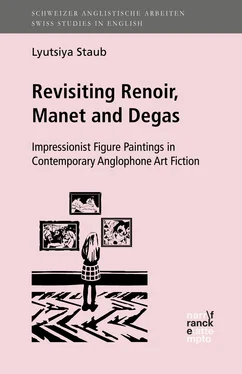
Lyutsiya Staub
Revisiting Renoir, Manet and Degas
Impressionist Figure Paintings in Contemporary Anglophone Art Fiction
Narr Francke Attempto Verlag Tübingen

© 2019 • Narr Francke Attempto Verlag GmbH + Co. KG
Dischingerweg 5 • D-72070 Tübingen
www.narr.de• info@narr.de
Das Werk einschließlich aller seiner Teile ist urheberrechtlich geschützt. Jede Verwertung außerhalb der engen Grenzen des Urheberrechtsgesetzes ist ohne Zustimmung des Verlages unzulässig und strafbar. Das gilt insbesondere für Vervielfältigungen, Übersetzungen, Mikroverfilmungen und die Einspeicherung und Verarbeitung in elektronischen Systemen.
ISBN 978-3-7720-8700-4 (Print)
ISBN 978-3-7720-0213-7 (ePub)
To my grandmother, Katusha, who taught me to love books.
The visual arts have always been a source of inspiration for writers, from classical antiquity (starting from Homer, who included a description of the Shield of Achilles in Book 18 of the Iliad ) to the present. However, it seems that early twenty-first century literature, more than ever before, is geared towards visuality through the use of visual images in verbal texts. The recent upsurge in the popularity of the word-image relationship is especially noticeable in the contemporary novel, which not only focuses on works of art, artists’ and models’ lives and the artist-model relationships, but also, while fictionalising the story of the very process of creating an artwork, seeks to test and evaluate its historical interpretation. While a variety of definitions of this particular genre have been suggested – “fictions about painters” (Bowie), “artist novels” (Beebe), “atelier narratives” (Joyce) and most recently “art-historical fiction” (Chapman) –, this paper will address it simply as art fiction . My concern is primarily with contemporary novels that allude to two-dimensional works of art, Impressionist figure paintings by Renoir, Manet and Degas in particular. Although my work focuses on literature, I hope this research will also be of interest for art experts, as art fiction does not only re-present a painting to make the reader see it through its description but creates a story around it, and by that delves deeper into the question of possible meanings of an artwork.
The purpose of this study is to analyse the relationship between visual art and contemporary art fiction by addressing the problem of the ekphrastic re-presentation and re-interpretation of an Impressionist figure painting through its composition, selected details of the painting and allusion to specific techniques used in the process of creating the masterpiece based on the examples of the following novels: Luncheon of the Boating Party ( LOTBP ) by Susan Vreeland (2007), Mademoiselle Victorine ( MV ) by Debra Finerman (2007), With Violets ( WV ) by Elizabeth Robards (2008), Dancing for Degas ( DFD ) by Kathryn Wagner (2010) and The Painted Girls ( TPG ) by Cathy Marie Buchanan (2013). The reason for choosing the corpus of five novels about Impressionists is twofold: the scope of the study is narrowed down, on the one hand, to a single period of literature and, on the other, to a specific period of art history. The overall aim of reducing of the scope of the corpus of texts is to avoid further risk of the study being too broad and unintentionally ambiguous.
Impressionism1 is probably one of the most popular movements with audiences – it is light, pretty to look at and easy to understand. Barbe-Gall points out that Impressionist paintings do not require prior knowledge and thus offer certain comfort to contemporary viewers who are usually able to “recognise something familiar in the paintings, something they have once experienced, or simply glimpsed, an ordinary situation or a passing sensation” (4). According to Brettell, the main attraction of these “joyous works remains the sense of spontaneity they impart, the pure pleasure they suggest in the artist’s act of looking and in the ability to capture a quick visual impression, seemingly without second thought or the aid of theory” (7). In the second half of the nineteenth century, however, in comparison to the mainstream work of artists accepted by the Institut2 and the Salon, Impressionist paintings looked rushed, incomplete and utterly incompetent, and thus caused bitter opposition and received fierce criticism from both the art critics and the audience. Impressionists step aside from traditionally approved historical or mythological subjects and find theirs in everyday ‘real’ life. They depict what they see and illustrate their subjective point of view. The work that emerges from this personal vision becomes rather relative.3 It is both the subject itself and the effects of the natural light on this subject that interests Impressionists and makes them rethink and adjust the manner they paint and by implication the dynamics of the painting process. According to Baxandall, Impressionism offers “canvases that [play] on a tension between an openly dabbed-on plane surface and a rendering of sense-impressions of seen objects that put emphasis on their hues” (45). The practical innovation of ready-made paint in tubes was one of the reasons why Impressionists could paint much more quickly than their predecessors and were able to take their work outdoors . They developed various techniques – visible brush strokes, impasto, alla prima , en plein air – and tried to adapt them in order to reveal the subject through soft forms, representing a shimmering texture of light, fostering an illusion of movement and depicting the instancy of a ‘real’ moment of modern life. Many talented artists are known as Impressionists and although there are certain similarities in their philosophy of painting, their works appear materially different – the style and preferred subject matters of each painter can be clearly distinguished. Therefore, Impressionism cannot be reduced to just a few aspects and be spoken about in general terms – each painter should be studied individually.
Impressionism has been so popularised through countless reproductions on posters, calendars, napkins, umbrellas, chocolate boxes and the like that people are sometimes surrounded by Impressionist art without even knowing it. Now Impressionist paintings and painters are subjected to another form of recycling – they penetrate the pages of art fiction. In the last ten years many contemporary writers (Vreeland, Finerman, Robards, Wagner, Buchanan, Cowell, Oliveira, Figes, Lasky, Scott Chessman, Gibbon – to name just a few) have turned to the subject of Impressionism, creating portrayals of famous Impressionists and their models, developing the stories of their relationships, yet also focusing on re-presentation (by describing the process of their creation and exploring it from both the artist’s and the model’s perspectives) and interpretation of the artworks. Analysis of ekphrastic re-presentation of an Impressionist artwork is particularly interesting in view of the fact that in Impressionist painting attention is diverted from separate details to the overall effect of the image, yet it is usually the composition and the details of the painting that help to re-present the visual source verbally. The aim of this study is therefore to examine how Impressionist figure paintings are re-presented through the composition of the painting and selected details and how such re-presentation affects the re-interpretation of an artwork alluded to in the narrative as well as the understanding of an extant work of art.
Читать дальше














